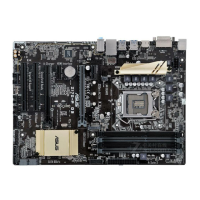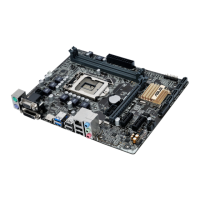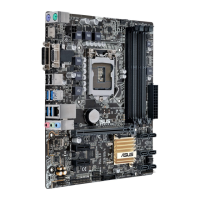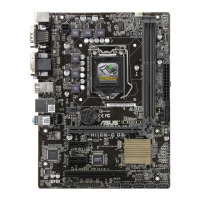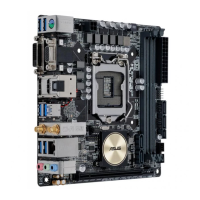2.5.10 DRAM Timing Control
ThesubitemsinthismenuallowyoutosettheDRAMtimingcontrolfeatures.Usethe
<+>and<->keystoadjustthevalue.Torestorethedefaultsetting,type[auto]usingthe
keyboardandpressthe<Enter>key.
Changingthevaluesinthismenumaycausethesystemtobecomeunstable!Ifthis
happens,reverttothedefaultsettings.
2.5.11 DIGI+ VRM
CPU Load-Line Calibration [Auto]
Load-lineisdenedbyIntelVRMspecicationandaffectstheCPUpowervoltage.TheCPU
workingvoltagewilldecreaseproportionallydependingontheCPUloading.Higherlevels
oftheload-linecalibrationcangetahighervoltageandabetteroverclockingperformance
butincreasestheCPUandVRMthermal.Selectfromlevel1to7toadjusttheCPUpower
voltagefrom0%to100%.Congurationoptions:[Auto][Level1][Level2][Level3][Level4]
[Level5][Level6][Level7]
TheboostedperformancemayvarydependingontheCPUspecication.Donotremove
thethermalmodule.
CPU Current Capability [Auto]
Allowsyoutocongurethetotalpowerrange,andextendstheoverclockingfrequencyrange
simultaneously.Congurationoptions:[Auto][100%][110%][120%][130%][140%]
Chooseahighervaluewhenoverclocking,orunderahighCPUloadingforextrapower
support.
CPU VRM Switching Frequency [Auto]
ThisitemaffectstheVRMtransientresponsespeedandthecomponentthermalproduction.
Select[Manual]tocongureahigherfrequencyforaquickertransientresponsespeed.
Congurationoptions:[Auto][Manual]
DONOTremovethethermalmodule.Thethermalconditionsshouldbemonitored.
ThefollowingitemappearsonlywhenyousettheCPUVRMSwitchingFrequencyto
[Manual].
Fixed CPU VRM Switching Frequency (KHz) [250]
Thisitemallowsyoutosetahigherfrequencyforaquickertransientresponsespeed.
Usethe<+>and<->keystoadjustthevalue.Thevaluesrangefrom250KHzto
500KHzwitha50KHzinterval.
CPU Power Duty Control [T.Probe]
DIGI+VRMDutycontroladjuststhecurrentandthermalconditionsofeverycomponents
phase.
[T.Probe]SelecttomaintaintheVRMthermalbalance.
[Extreme]SelecttomaintainthecurrentVRMbalance.
2-22 Chapter 2: Getting started

